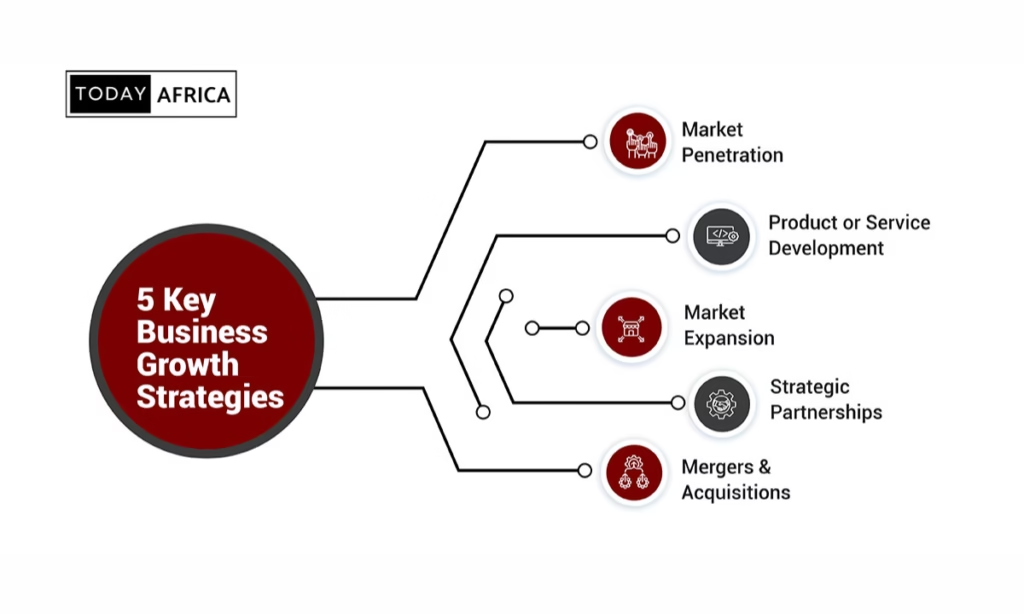In the business environment, having a well‐defined growth strategy isn’t just a luxury—it’s a necessity.
Whether you’re a startup or an established enterprise, understanding how to develop a business growth strategy can help you stay competitive, optimize resources, and drive long‑term success.
In this article, we’ll cover the fundamentals of business growth strategy and how to develop a business growth strategy.
What is Business Growth Strategy?
A business growth strategy is a roadmap that outlines the tactics, initiatives, and goals your company will pursue to increase revenue, expand market share, and reach new customer segments. It is more than just setting annual targets—it involves looking at your market, understanding your competitive landscape, and making strategic decisions that will position your business for sustainable expansion.
Why a growth strategy matters
Developing a clear growth strategy helps you:
- Identify new opportunities: By analyzing market trends and customer behaviors, you can pinpoint untapped markets or niches.
- Optimize resources: A strategy aligns your resources with your goals, ensuring you invest time and money where they matter most.
- Mitigate risks: With a growth plan, you are better prepared to handle market disruptions and competitive pressures.
- Drive long‑term success: It keeps your team focused on common goals and helps you adjust tactically as conditions change.
According to business experts, having a structured growth plan can be the difference between stagnation and explosive success
Read Also: How I Built a Successful PR and Digital Marketing Agency – Nomsa Mdhluli
Key Components of a Business Growth Strategy
Before diving into the step‑by‑step process, it’s essential to understand the core components that make up a solid growth strategy:
1. Vision and objectives
Start by defining your long‑term vision. What does success look like for your business in five or ten years? Clear objectives give your strategy purpose and direction.
2. Market analysis
Conduct a thorough analysis of your industry, competitors, and target market. Identify trends, market gaps, and areas where your business can uniquely excel.
3. SWOT analysis
Evaluate your Strengths, Weaknesses, Opportunities, and Threats (SWOT). This analysis provides a snapshot of where your business stands and highlights areas for improvement.
4. Customer analysis
Understanding your customer’s needs, behaviors, and pain points is crucial. Develop buyer personas to target your messaging effectively.
5. Financial planning
Establish realistic revenue goals and assess the financial resources available to support growth initiatives. Financial planning should include budgeting for marketing, hiring, and technology investments.

6. Risk management
Identify potential risks—such as market fluctuations or competitive pressures—and develop contingency plans to mitigate them.
7. Tactical initiatives
Outline specific actions such as product development, market penetration, and customer acquisition strategies that will help achieve your high‑level goals.
Step‑by‑step Guide: How to Develop a Business Growth Strategy
Now that you know the key components, let’s walk through a detailed process to develop your growth strategy.
Step 1: Define your vision and set high‑level goals
Begin with a clear vision of where you want your business to be in the future. Ask yourself:
- What is my long‑term goal?
- How do I envision my business in 5–10 years?
- What revenue growth do I aim to achieve?
Setting Big, Hairy, Audacious Goals (BHAGs) can inspire your team to work toward ambitious targets. Use the SMART criteria (Specific, Measurable, Achievable, Relevant, Time‑bound) to refine these goals
Step 2: Analyze your current situation
Conduct a comprehensive SWOT analysis:
- Strengths: What does your business do well? Consider factors such as brand reputation, customer loyalty, or proprietary technology.
- Weaknesses: Identify areas where improvement is needed, such as limited market reach or operational inefficiencies.
- Opportunities: Look for emerging trends, new markets, or technological advancements.
- Threats: Be aware of external challenges like new competitors or economic downturns.
This analysis forms the foundation upon which you can build your growth plan.
Step 3: Conduct market research
Dig into industry reports, competitor analyses, and customer surveys to understand the market landscape. Ask questions like:
- What are the current market trends?
- Who are your main competitors and what strategies are they using?
- What customer needs are currently unmet?
By integrating market research with your keyword insights, you’ll gain a deeper understanding of what your potential customers are searching for and how to address those needs. For instance, analyzing search data for “how to develop a business growth strategy” can reveal additional long‑tail keywords that you should target.
Step 4: Identify your target audience
Define clear buyer personas that represent your ideal customers. Consider demographics, behaviors, and pain points. Tailoring your strategy to meet the specific needs of your target audience increases your chances of success. Use your keyword research to understand the language they use and the questions they ask online.
Step 5: Set SMART goals and objectives
Based on your vision and market analysis, set measurable objectives that align with your business goals. Examples of SMART goals might include:
- Increase monthly revenue by 20% within the next year.
- Grow your customer base by 15% in six months.
- Improve customer retention rates by 10% by implementing a loyalty program.
Clear, quantifiable goals help you track progress and adjust tactics as needed.
Step 6: Develop tactical initiatives
Now it’s time to outline the specific strategies and tactics that will drive growth. Consider the following:
- Market penetration: Increase sales of existing products within your current market. Tactics include promotions, improved distribution channels, and pricing adjustments.
- Market development: Expand into new geographical areas or customer segments. This might involve localized marketing campaigns or partnerships with local distributors.
- Product development: Innovate or enhance your product offerings to better meet customer needs.
- Diversification: Explore new business opportunities or product lines that complement your core offerings.
For each initiative, define the action steps, resources required, responsible team members, and deadlines. This detailed roadmap will serve as your playbook for execution.
Step 7: Create a detailed implementation plan
An effective growth strategy isn’t just about planning—it’s about execution. Develop a comprehensive implementation plan that includes:
- Action items: Break down each initiative into specific tasks.
- Timelines: Set realistic deadlines for each task.
- Resource allocation: Determine the budget, technology, and human resources needed.
- KPIs and metrics: Identify key performance indicators to measure progress (e.g., revenue growth, customer acquisition cost, conversion rates).
This plan ensures that everyone on your team understands their responsibilities and the overall timeline for achieving your goals.
Step 8: Execute and monitor your Strategy
With your plan in place, it’s time to put it into action. Key steps include:
- Communication: Keep your team informed with regular updates and progress reports.
- Monitoring: Use analytics tools (such as Google Analytics, SEMrush, or custom dashboards) to track KPIs and monitor performance.
- Adjustments: Be prepared to pivot your tactics if certain initiatives aren’t delivering the expected results. Continuous optimization is key to sustainable growth.

Step 9: Review, learn, and optimize
The business environment is constantly evolving, so your growth strategy should be flexible. Regularly review your performance data and hold strategy meetings to assess:
- Which initiatives are driving the most growth?
- What challenges or obstacles have emerged?
- How can you optimize your approach based on new market trends or customer feedback?
Learning from both successes and setbacks will help you refine your strategy and ensure long‑term success.
Read Also: What is Digital Marketing Mix?
Case Studies and Real‑world Examples
Understanding theory is important, but seeing how real companies develop and execute growth strategies can provide invaluable insights. Here are a few examples:
Example 1: Apple’s strategic growth
Apple’s growth strategy is centered on continuous innovation and an unwavering focus on user experience. By regularly updating its product line and expanding its ecosystem (e.g., the integration of hardware, software, and services), Apple has maintained its market leadership even in highly competitive markets. Their approach includes:
- Investing heavily in R&D.
- Building a loyal customer base through quality and design.
- Creating an integrated ecosystem that encourages repeat purchases and customer retention.
Apple’s success shows how a well‑defined strategy can drive exponential growth while keeping profitability in focus.
Example 2: Market penetration in the fast‑food industry
Market penetration strategies are common in industries where consumer loyalty is critical. Consider McDonald’s: by continually refining its menu, investing in marketing campaigns, and ensuring consistent quality across locations, McDonald’s has been able to maintain a dominant position in the fast‑food market. Tactics such as promotions, pricing strategies, and localized marketing have helped McDonald’s increase its market share over the years.
Example 3: Diversification by Amazon
Amazon started as an online bookstore and has evolved into a global e‑commerce and technology giant. One of the keys to Amazon’s growth has been diversification. By expanding into new product categories, launching cloud computing services (Amazon Web Services), and exploring new markets like entertainment (Amazon Prime Video), Amazon has built a robust growth platform that continues to drive revenue from multiple stream.
Best Practices and Tips for Success
Implementing a successful business growth strategy requires attention to detail, constant monitoring, and a willingness to adapt. Here are some best practices:
1. Focus on execution
A strategy is only as good as its execution. It’s not enough to have a brilliant plan if you don’t follow through. Create accountability by assigning clear roles, setting deadlines, and holding regular review meetings to track progress.
2. Stay agile and flexible
Markets change rapidly. Ensure your strategy includes periodic reviews and adjustments. This way, you can pivot quickly when faced with new challenges or opportunities.
3. Foster a culture of innovation
Encourage your team to think creatively and share ideas. Innovation should be part of your company’s DNA, enabling you to continuously refine your products, services, and customer experiences.
4. Use data to drive decisions
Leverage analytics and performance metrics to guide your decisions. Data-driven insights can help you understand what’s working and where you need to make improvements. Tools such as Google Analytics, SEMrush, and custom dashboards are invaluable for this purpose.
5. Invest in your team
Your employees are your most valuable asset. Invest in training, development, and fostering a collaborative environment that empowers your team to take ownership of growth initiatives.
6. Leverage strategic partnerships
Collaborations and partnerships can open up new markets and opportunities. Whether it’s through joint ventures, technology alliances, or distribution partnerships, working with others can accelerate growth.
7. Monitor competitors
Keep an eye on what your competitors are doing. A competitive analysis helps you understand market trends and discover areas where you can differentiate yourself.
8. Plan financially for growth
Ensure that your financial planning aligns with your growth initiatives. Secure adequate funding, control costs, and monitor cash flow closely to support your expansion plans.
9. Prioritize customer experience
A satisfied customer is the best growth engine. Focus on delivering exceptional customer service and building strong relationships. Happy customers are more likely to become repeat buyers and brand advocates.

Common Pitfalls and How to Avoid Them
Even the best strategies can falter if common pitfalls are not addressed. Here are some challenges to watch for:
1. Overexpansion
Expanding too quickly without proper infrastructure can strain your resources. Ensure you have the systems and processes in place to support growth before scaling up.
2. Neglecting market research
A lack of thorough market and competitor analysis can lead to misguided initiatives. Continuously update your research to stay on top of trends and customer needs.
3. Ignoring financial constraints
Growth initiatives require investment. Failing to secure sufficient funding or mismanaging cash flow can derail even the most promising strategies.
4. Poor communication
Misalignment within your team can lead to confusion and inefficiencies. Ensure that everyone understands the strategy, their role in it, and the overall objectives.
5. Inadequate monitoring
Without regular reviews, you may miss early warning signs of underperformance. Establish a robust monitoring system to track KPIs and adjust tactics as needed.
By being aware of these pitfalls and proactively addressing them, you can increase the likelihood of a successful growth strategy.
Read Also: What is Marketing Mix in Business?
Conclusion
Developing a business growth strategy is both an art and a science. It requires a clear understanding of your business, rigorous market, and a disciplined approach to planning and execution. By following the steps outlined in this guide, you’ll be well on your way to building a strategy that fuels sustainable growth.
Remember, the key to long‑term success isn’t just in setting goals—it’s in executing them flawlessly while staying agile enough to pivot when necessary. Use data to guide your decisions, invest in your team, and continuously innovate to keep your business ahead of the curve.
By prioritizing a customer‑centric approach, maintaining rigorous monitoring, and learning from both successes and setbacks, you can turn your growth strategy into a dynamic, ever‑evolving roadmap for success. Embrace the challenge, and let your business growth strategy drive you toward new heights.
For more insights on business growth, digital marketing, and strategic planning, be sure to check out our other blog posts and resources. Whether you’re looking to refine your current strategy or build one from scratch, the journey to sustainable growth starts with a single, well‑planned step.
Leave a comment below and follow us on social media for update:
- Facebook: Today Africa
- Instagram: Today Africa
- Twitter: Today Africa
- LinkedIn: Today Africa
- YouTube: Today Africa Studio
















